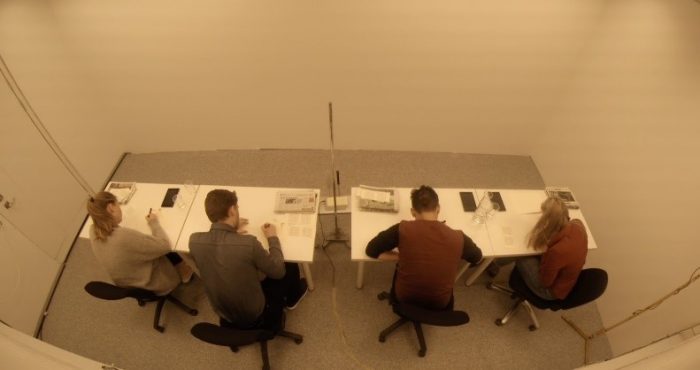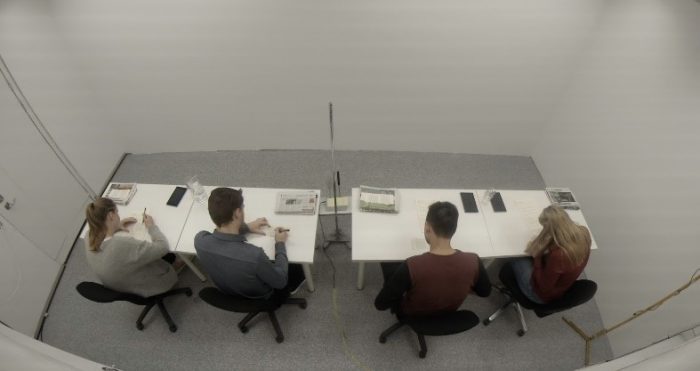
Conditioning of built environments dominates global energy use and greenhouse gas emissions. If lighting can be used actively to stimulate our perception of the thermal environment, there may be a potential to expand the temperature interval that building occupants find comfortable and thereby reduce the amount of energy used to heat and cool buildings.
This was the hypothesis of our recently-completed study that explored how lighting characteristics can nudge our perception of other indoor environment domains.
Usually, the rate at which the body exchanges heat with the surroundings determines if we feel cold or warm. However, evidence in the literature suggests that also visual stimuli, in addition to parameters related to the body’s heat balance, may affect thermal perception. New and energy-efficient LED technology that allows for easy control of the spectral distribution of light may be one way to utilize this in practice.
At first, we tested this in a controlled environment chamber without daylight access. Human subjects were exposed to white light of correlated color temperatures (CCT) at around

Subjects in chamber at 2700 K. Image courtesy Jørn Toftum

Subjects in chamber at 6200 K. Image courtesy Jørn Toftum
to 6200 K. To stimulate a response from the subjects, the illuminance intensity in these experiments was rather high, corresponding to 1000 lux. Ambient temperatures were either on the upper or lower boundaries of the summer and winter thermal comfort envelopes or at a temperature optimal for winter comfort. During the exposures, subjects rated their perceptions of the visual, thermal, acoustic, and atmospheric environment on designated scales included in a paper-based questionnaire.
We expected to see an effect of lighting on subjects’ thermal response most clearly on the edges of the temperature comfort envelope. However, at the lowest and highest of the applied temperatures, 19oC and 27oC, the association between CCT and the thermal sensation was not significant, indicating that the heat balance at these temperatures probably dominated the perceptive thermal response. Only at 22oC did an increase of the CCT result in a significantly colder thermal sensation. There was also a significant interaction between CCT and gender indicating that females’ thermal sensation decreased more with increasing CCT than did males’. Correspondingly, female subjects preferred a higher temperature, with increasing CCT at 22oC, more so than males. Moreover, subjects felt more alert and perceived the air quality as being better in high than in low CCT.
Increasing the CCT from 2700 K to 6200 K at a comfortable temperature shifted subjects’ mean thermal sensation equal to an equivalent temperature difference of 1.7oC. Based on this, energy and indoor environment simulations of a typical Danish office building estimated the potential energy saving to 8% of the building’s total annual energy use when the building was located in a cool temperate climate. This was achieved by reducing the heating set point and compensating by an equivalent decrease of the CCT.
In practice, a range of disturbing factors including daylight, light from computer monitors, lower illumination, and a more diverse color scheme on office walls may affect the association between CCT and thermal response. Some of these factors were investigated in two follow-up studies; one controlled exposure study in which subjects completed rating scales on a computer at a lower illuminance of 500 lux and a field intervention study in a building in practice, which had controllable LED lighting installed.
With lower illumination and light from computer monitors, the association between the CCT and the thermal sensation was weak and not significant. The light was generally experienced as being very bright when the subjects used the computer monitor, independent of the CCT of the lighting in the room. In contrast, when the subjects were not using a computer, the light was experienced as clearly more bright with increasing CCT.
Vision changes as we grow older and the association between CCT and thermal perception may, therefore, be different in different age groups. Comparison of responses to lighting exposure of two groups of subjects with mean ages of 24 years and 44 years showed that there was no difference in their perceived thermal sensation when the CCT was changed. However, the older group of subjects could not distinguish differences in the CCTs above 4000 K.
A field intervention study was finally carried out in an office building in which the lighting system allowed control of the CCT and illuminance intensity in three separate sections. Three settings of the CCT of approximately 3200 K, 3600 K, and 4600 K were tested during seven weeks in the winter season when the daylight hours were at a minimum. Under these conditions, no association was found between the CCTs and thermal sensation or the perceived air quality. The results suggested that the relative high CCT was perceived brighter and preferred darker when compared to the low and medium settings, confirming the findings from the controlled exposures in the climate chamber.
Can we then use lighting in buildings to manipulate our thermal sensation and save energy? Not really, as the magnitude of the effect of lighting on thermal perception is rather modest and only visible under exceptional and tightly controlled conditions that do not mirror real buildings. However, the findings suggest that the different domains of the indoor environment interact to some degree, but also that the strength of the interaction varies with the domain and the type of perceptual outcome.
The human sensory system integrates and processes a multitude of inputs, e.g. thermal, atmospheric, visual, and acoustic, which potentially could be considered in the design and operation of buildings and their technical systems. This would be a paradigm shift compared with current practices, which tend to focus on only one aspect of the indoor environment at a time.
These findings are described in the article entitled Occupant response to different correlated colour temperatures of white LED lighting, recently published in the journal Building and Environment. This work was conducted by Jørn Toftum and Anders Thorseth from the Technical University of Denmark, and Jakob Markvart and Ásta Logadóttir from Aalborg University Copenhagen.









